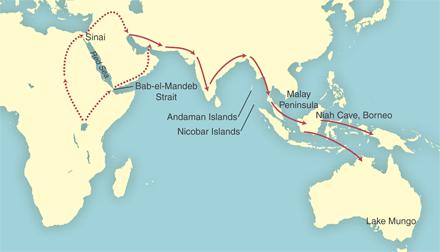When fully modern humans left Africa, their journey is often described as the “colonization” or “peopling” of the world. Characterizing things this way can give rise to the mistaken impression that the journey out of Africa was unprecedented and unique. This of course ignores the fact that human ancestors pulsed out of Africa multiple times during the preceding 1.8 million years, and that adaptive radiations are commonplace among animals. During the Eocene and Oligocene, primates radiated from America to Europe and Asia to Africa and Africa to America. There is nothing particularly special about migrations, colonizations, and radiations.
There may however be something special about the relatively recent and fully modern human pulses out of Africa. When humans arrive in Europe and Australia about 45,000 years ago, we find tell-tale archaeological signatures ranging from burials to tools. The most salient signature is evidence of symbolic thinking, the proxies for which are usually carved figurines, grave goods, personal adornment, and rock art. Evidence of symbolic behavior is, in turn, usually taken to be a proxy for language fluency. My reasoned assumption has always been that where we find symbolism-language, supernatural beliefs and ritual activities are also present.
Although there is a general sense that the humans who most recently left Africa to colonize the world were symbolically and linguistically modern, this sense is troubled by the fact that the earliest and most compelling evidence for these abilities comes from Europe. The African record hints at these abilities some 75,000 years ago in the form of new tools, ochers, and adhesives, but persuasive symbolic proxies such as figurines and art are lacking. Hence we have a gap between presumably modern humans in Africa some 75,000 years ago and undoubtedly modern humans in Europe 45,000 years ago.
One possible way of bridging this gap is to look for evidence of symbolic behavior along the migration routes which led to the peopling of Australia. This is precisely what Jane Balme and colleagues did in “Symbolic Behaviour and the Peopling of the Southern Arc Route to Australia” (2009). Because the coastal migration routes followed by humans 75,000-45,000 years ago are now mostly submerged due to rising sea levels, it is not surprising that the evidence is sparse.


As the authors observe, even less of this evidence is symbolic:
[T]he earliest unambiguous evidence for symbolic behavior in South Asia is the ostrich egg shell beads dated to 28,500 years; the earliest explicitly symbolic artefacts are found on the Indian subcontinent between about 30,000 and 20,000 years ago. In Wallacea and Australia the earliest evidence for symbolism overlaps with the time of the arrival of people in Australia and includes painted rock fragments dated to 42 ka from Carpenter’s Gap in the Kimberley…there is evidence for ritual burial practices at Lake Mungo, about 40,000 years ago, in the form of cremation and fragmentation of one body and the use of sprinkled ochre on the extended burial of another.
This relatively limited record has caused several researchers to observe that “evidence for symbolic artefacts associated with the colonisation
of Australia is slight compared to the record for the colonization of Europe by anatomically modern humans.” While Balme and colleagues don’t disagree, they argue that the migrants surely were capable of symbolic behavior. In support, they contend that the colonists traversed several kinds of challenging environments (from desert to plain to jungle) and boats were needed for some crossings. To the authors this suggests complex or modern cognition:
The crucial point to be made, however, is the theoretical position that the rapid colonization of the southern arc indicates that it was colonised by people engaged in complex information exchange systems, who displayed planning depth and conceptualisation and these attributes were all bound up with the development of language.
While this is probably true, the limited data do not compel the conclusion. As things currently stand, there isn’t much evidence for symbolism along the route or at the early Australian destinations. We can infer symbolism-language but this doesn’t really bridge the gap between maybe symbolic Africa 75,000 years ago, definitively symbolic Europe 45,000 years ago, and probably symbolic Australia 45,000 years ago.
We still don’t know whether the first moderns out of Africa were linguistically fluent or whether such fluency developed along the way. Regardless, I don’t think symbolism or language was necessary for such a journey. The ancient presence of Homo erectus in Indonesia and Homo floresiensis or Hobbit on the Island of Flores certainly suggest this.
Reference:
Balme, J., Davidson, I., McDonald, J., Stern, N., & Veth, P. (2009). Symbolic behavior and the peopling of the southern arc route to Australia Quaternary International, 202 (1-2), 59-68 DOI: 10.1016/j.quaint.2008.10.002



